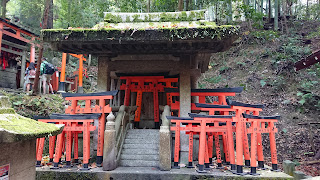More bullet training got us to Kyoto. On the bullet trains the distances between the various Japanese cities just disappear. It's a very nice change from the huge distances and travel times we had in China. Kiki took us (deliberately) only one stop on the train, so we could get a different service that originated at that station and would therefor be able to get seats. This was a great hack, as you can see that the first train we got on was rather packed with Kiki and I stuck with all the bags in the doorway.
We went to the Nijo Castle, built by the first shogun of the Edo Period (1603-1867), and his seat of government for all of Japan. We were there on the day the new Emperor was being crowned, and entry was free just for that day. Kiko saved up the money and bought us a treat later since the entrance fee had been budgeted for :-)
The 'castle' wasn't really what I would think of a castle. It did have very impressive and tall stone walls and a moat, but inside it was much less defensive. Beautiful gardens and paper walls won't really keep people out! The castle did have many beautifully painted screen doors, but no photos allowed unfortunately. There was also almost no furniture or historic items in the castle, leaving it rather stark and a little bit boring for me.
The castle did have
Nightingale floors in the more public areas, which I have read about before. This wooden flooring squeaks beautifully when walked on, and legend has it that it was a security measure against ninjas prowling around, though there seems to be some confusion over whether that is true. Our guide said it was, but then a sign said it was accidental. That the Nightingale floor was only in the more public areas of the castle leads me to believe that it was a security device. The more lived in/private areas of the castle don't have the squeaky flooring, (who wants squeaks when you have to go to the loo in the night), and if they were able to have non-squeaky floors I can only assume that where it was squeaky was a deliberate choice.
Next Kiki took us to an area where geisha live. Geisha are not prostitutes, this is a western misconception. Geisha is a lifestyle/calling, similar in some respects to nuns, where you become a geisha and live in that small community for the rest of your life. Geisha are entertainers, performing music, dance and other traditional entertainments for wealthy clients. There are not many of them, and they keep to themselves most of the time. Kiki took us to an area where they live at 6pm in the hopes of seeing some of them heading off to work, and we were lucky enough to see 3.
 |
| The one with the 'bigger' dress here is an apprentice |
Kiki told us that she contemplated becoming a geisha when she was younger, but I'm so glad she didn't or we wouldn't have had her as our excellent CEO.
From geisha alley we walked into town seeing the sights, and ended up at a sushi restaurant for dinner.
You can order what you like from the touch screen menu, or just choose from the conveyor belt. Was much fun!
 |
| This is how much I ate. |
 |
| This is how much a Japanese chap next to me ate! |
Next morning we headed for the Fushimi Inari Shinto Shrine. There are thousands Torii gates all the way up this hill and it was quite a sight to see. This shrine is dedicated to the god of harvests and business, and the kitsune (fox spirits) are here to protect the grain stores.
 |
Also it turns out that when you photobomb
other people, they often photobomb you back! |
Halfway up the hill my camera decided to stop reading the memory card again, and I decided it was time to give up on it and get a replacement. It's amazing how frustrated and annoyed I get when my camera breaks!
Next was out to Arashiyama to the bamboo forest there. Lunch by the river and we experimented with vertical panoramas in the bamboo forest. Turns out I can even photobomb a vertical panorama!
That evening, Ernesto and I opted for the Kembu performance and lesson. Kembu is an art form performed by samuri making use of their martial skills and fans. The fans were not used in combat, but are used to express many different concepts in the performances. They can be used to convey a variety of things, from wind, rain and snow, to leaves falling, to a bow and and arrow. After the performance we got to try out the clothes and the swords. A very good evening!
 |
| Samuri socks! |
 |
| Serious |
 |
| Not so serious! |
Dinner was omrice or something - rice wrapped in an omlet. Mine was grim and I didn't enjoy it at all, that'll teach me to stray from Kiki's recommendations. The wax menu items outside were probably just as tasty.







































































What a fascinating time you've had. i fell in love with the bamboo forests in China - Phoenix tail bamboo, just lovely.
ReplyDelete